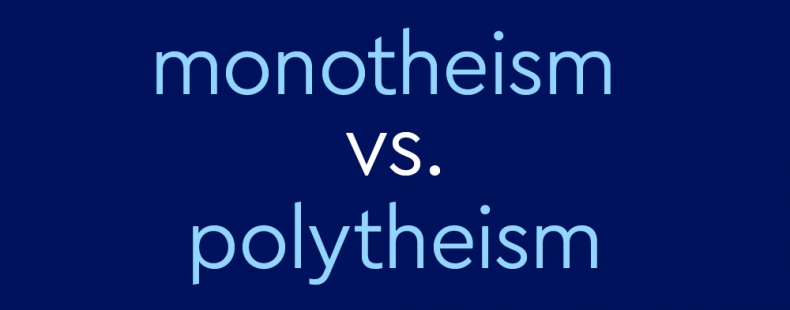By some estimates, there are more than 4,000 religions in the world. And while these beliefs vary widely, many of them can be generally categorized as forms of either monotheism or polytheism. The difference has to do with whether followers believe in or worship a single deity (supreme being) or multiple ones.
In this article, we’ll break down the difference, provide examples of monotheism and polytheism among major world religions, and define related words like theism, atheism, and pantheism.
⚡️Quick summary
Monotheism is a term for a belief system based on the belief in a single deity. Religions that are considered examples of monotheism include Judaism, Christianity, and Islam. Polytheism is a term for a belief system based on the belief in multiple deities. A prominent example is Hinduism.
What is monotheism?
Monotheism is the belief or doctrine that there is one—and only one—god or deity. The term is often used as a general label for specific religions (such as Judaism) that fall into this category. However, it can also be used outside the context of specific religions. For example, a person who does not profess belief in a specific religion but who believes there is one god could be said to adhere to the doctrine of monotheism.
A person who believes in only one god can be called a monotheist. The adjective form, monotheistic, is typically used in terms like monotheistic religions and monotheistic beliefs.
What is polytheism?
Polytheism is the belief or doctrine that there are multiple gods or deities. Like monotheism, the word polytheism can be used in the context of specific religions (such as Hinduism) or outside of formal religion.
A person who believes in multiple gods can be called a polytheist. The adjective form is polytheistic.
Where do monotheism and polytheism come from?
The words monotheism and polytheism share some of the same roots: the element the- is a form of theo-, a Greek root meaning “god,” and the suffix -ism is used in nouns that refer to specific doctrines or beliefs. The difference is in the beginning: mono- means “one,” while poly- means “multiple.”
There are several related words used in the context of religious beliefs. The word theism refers to the belief that some god or gods exist. Atheism is the belief that no gods exist—the prefix a- means “not” or “without.” (Atheism is distinguished from agnosticism, which is the belief that it’s impossible to know whether or not gods exist.)
Pantheism typically refers to the belief in an impersonal but all-encompassing god-force. The word henotheism can refer to a belief system that allows for the existence of multiple gods but involves the worship of only one.
Examples of monotheism and polytheism
Judaism and Islam are both well-known examples of monotheism. Many Christians believe in the three-part deity known as the Trinity, but Christian belief generally interprets this as one God, and Christianity is widely considered a monotheistic religion.
Perhaps the most widely-practiced polytheistic religion is Hinduism, which has many different branches (including some considered largely monotheistic). The religions of many different Indigenous peoples in different places are polytheistic. Ancient Greek and Norse peoples practiced polytheistic religions whose many gods we now know as part of what we call mythology.
The word god is often capitalized (as God) in the context of monotheistic religions but left lowercase in the context of polytheistic religions, but this usage varies and capitalization or noncapitalization may be used to indicate other things (such as a belief or a lack of belief in such deities).
Some religious and spiritual practices aren’t theistic at all—meaning they don’t involve the worship of a figure considered a deity. Buddhism, for example, is typically not considered a theistic faith. Remember: beliefs about the nature of a deity (or deities) being worshipped can vary even among followers of the same religion, and some faiths are not easily categorized.














